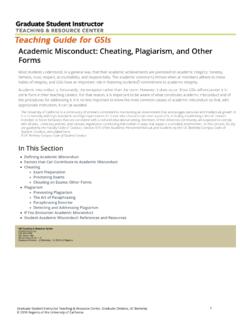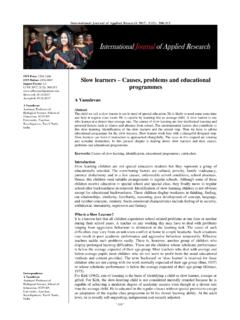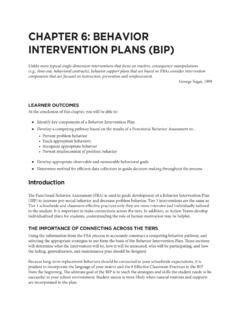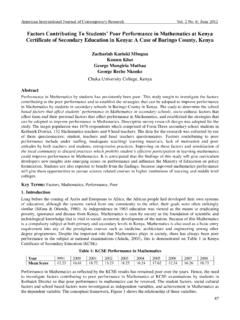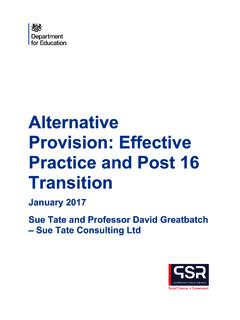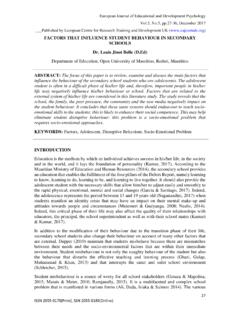Transcription of Conflict Management and Resolution Strategies between ...
1 Journal of Education and Practice ISSN 2222-1735 (Paper) ISSN 2222-288X (Online) , , 2017 63 Conflict Management and Resolution Strategies between Teachers and School Leaders in Primary Schools of Wolaita Zone, Ethiopia Engdawork Birhanu Shanka* Social Development Team Leader, Wolaita Development Association Mary Thuo Department of Educational Planning and Management , Wolaita Sodo University Abstract The purpose of this study was to investigate various Strategies used to manage and resolve Conflict between teachers and school leaders in government primary schools of Wolaita zone.
2 The study employed a descriptive survey design where both quantitative and qualitative approaches were used to correct and analyze data, concurrently. From six districts, ten schools were selected using both simple random and purposive sampling so as to include schools sponsored by Wolaita Development Association. Subjects for this study included 146 teachers and 50 department heads who were randomly selected to respond to the questionnaires. Participants for interview included 10 principals, 10 vice-principals, and 20 unit leaders and 30 parent and teachers association members.
3 Data were analyzed using descriptive statistics (frequency, percentages, means and standard deviations), and inferential statistics (t-test) using SPSS software version 20. Findings indicated that major causes of Conflict were either; institutional, work or leadership related. Major Conflict Management Strategies included; building leadership skills, following rules and regulations. embracing change, wise allocation of recourses, involvement in decision making, providing opportunities for training, and understanding individual differences and roles, In case of disputes, techniques included; discussions, punishing, forcing, compromising, avoidance, and ignorance.
4 This study concluded that school leaders need to understand the sources of conflicts and have a mechanism in place for staff to voice their concerns. Additionally, leaders need to continuously build leadership competences, be open to change, involve and provide staff with opportunities for growth. Besides, schools leaders should look for ways to acquire and expand funding sources. Keywords: Conflicts, Management , Resolution , Teachers, Leaders, Primary Schools, Ethiopia INTRODUCTION Effective Conflict Management takes central stage in creating safer and more supportive school learning environments.
5 Conflict occurs when different perceptions or opinions are contradictory in nature (Bano, Ashraf, & Zia, 2013; Ghaffar, 2010; Ramani & Zhimin, 2010). As noted by Adhiambo and Enose (2011), Conflict brings stress and discomfort due to the fear of the unknown; hence, it is a depressing and frustrating state of affair between the parties involved. Conflict affects the smooth running of the teaching and learning process, but, if carefully examined and managed it leads to peaceful coexistence between teachers and their school leaders. However, Conflict is inevitable, and in principle all conflicts cannot be resolved and managed (Ramani & Zhimin, 2010).
6 However, researchers argue that teachers and school leaders should have sufficient knowledge about how Conflict occurs, and how they can respond or manage it so as to bring positive changes and to minimize any negative effects (Olubunmi, 2014; Uchendu, Anijaobi-Idem, & Odigwe, 2013). Conflict is described in Aja, (2013, p. 2009) as an opposition or competition between two or more forces arising either from the pursuit of incompatible goals or a class of rival opinions. On their part, Oboegbulem and Alfa (2013, ) view Conflict as a struggle over values or claims to status, power, and scarce resources in which the aims of the conflicting parties are not only to gain the desired values, but also to neutralize, injure or eliminate the rivals.
7 Researchers have paid much attention to the issue of Conflict in organizations due to its large costs and benefits. Oboegbulem and Alfa (2013) pointed out that in all human interactions especially organizations, conflicts are bound to occur. Like other organizations, conflicts are inevitable in schools due to the collection of people with diverse personalities. Conflict may be destructive if it leads to ineffective communication breakdown and work relationships, tension, argument, low performance of team members and hostility which in turn affects the smooth running of the schools (Bano et al.)
8 , 2013; Makaye & Ndofirepi, 2012). However, if conflicts are properly handled, benefits may accrue; contributing to solidarity within conflicting groups and reconciliation of legitimate interests where, in turn, relationships are strengthened, there is enhanced identification of problems and solutions, increased knowledge/skill, and peace is safeguarded (Bano et al., 2013; Ramani & Zhimin, 2010). Ability to manage or resolve Conflict is therefore important for school leaders for smooth running of the school. Conflict Management and Conflict Resolution differ as shown in literature.
9 Ramani and Zhimin (2010) describe Conflict Management as an ongoing process that may never have a Resolution . Bano et al. (2013) on Journal of Education and Practice ISSN 2222-1735 (Paper) ISSN 2222-288X (Online) , , 2017 64 their part refer Conflict Management to a process of removing cognitive barriers to agreement .. between two parties. In contrast, Conflict Resolution is described by Doe and Chinda (2015, ) as the reduction, elimination, or termination of all forms of conflicts.
10 According to Doe and Chinda Conflict Resolution require negotiations, bargaining, mediation and arbitration. Problem Statement Studies focusing on conflicts show that working with peoples in the organizations involves dealing with many different kinds of problems (Okotoni & Okotoni, 2003). Like organizations, the consequences of Conflict between teachers and school leaders have been regrettable. Oboegbulem and Alfa (2013, ) pointed out that part of the outcome related with conflicts is disruption of academic programs, inadequate staffing due to unplanned transfers, hostility among staff members, suspicion and withdrawal from active participation in school activities.










